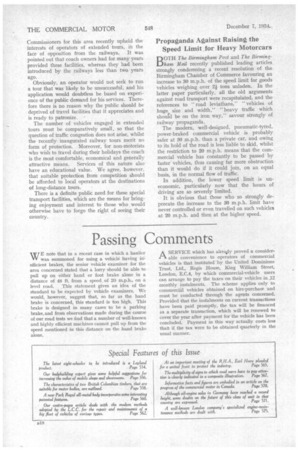Passing Comments
Page 32

Page 33

If you've noticed an error in this article please click here to report it so we can fix it.
WE note that in a recent case in which a haulier was summoned for using a vehicle having inefficient brakes, the senior vehicle examiner for the area concerned stated that a lorry should be able to pull up on either hand or foot brake alone in a distance of 48 ft. from a speed_ of 20 m.p.h., on a
level road. This statement gives an idea of the standard to be expected by vehicle examiners. We would, however, suggest that, so far as the hand brake is concerned, this standard is too high. This brake is designed in many cases to be a parking brake, and from observations made during the course of our road tests we find that a number of well-known and highly efficient machines cannot pull up from the speed mentioned in this distance on the hand brake alone.
ASERVICE which has alreaily proved a considerable convenience to operators of commercial vehicles is that instituted 'by the United Dominions Trust, Ltd., Regis House, King William Street, London, E.C.4, by which commercial-vehicle users can arrange to pay the taxes on their vehicles in .12 monthly instalments. The scheme applies only to commercial vehicles obtained on hire-purchase and must be conducted through the agents concerned. Provided that the instalments on current transactions have been paid promptly, the tax will be financed as a separate transaction, which will be renewed to cover the year after payment for the vehicle has been concluded. Payment in this way actually costs less than if the tax were to be obtained quarterly in the usual manner. AN idea of the vast extent of the sugar-beet industry in this country and of the amount of beet which has to be transported may be gathered from the fact that at the Central Sugar Company's factory at Peterborough this season, up to a few days ago,
over 175,000 tons of beet have been sliced. It is expected that the campaign will last until the end of January and will constitute a record ; the weekly tonnage received approximates 22,000.
THE chief engineer of the Chloride Electrical Storage Co., Ltd., maker of Exide batteries, has recently published some interesting notes in the company's house magazine. He points out that a battery can give a high or low output according to whether it is hot or cold. A battery with a rated capacity of, say, 100 amp-hours, at the 10-hour rate at 80 degrees F., will, at a temperature of, say, 125 degrees F., give a discharge of 169 amp.-hours, whereas the same battery at 5 degrees F. will give only 60 amp.-hours between charges. The reason for this is that the voltage depends upon the internal resistance ; the lower the resistance the higher the voltage, and the higher the temperature the lower the resistance, consequently, the longer the duration of the period of discharge before the voltage falls to the permissiblo final value. THE Fowler Gyrotiller is a haulier's machine, in the sense that it is customary for it to be purchased by hauliers and used by them for farmer customers. The results of the use of a Gyrotiller on a beet field in Yorkshire are therefore of interest. Most of the field was gyrotilled. A strip was ploughed and cultivated by ordinary means. The beet from the latter strip was small, clubby and fangy ; all that from the rest of the field was beautiful in shape, long, and fangl ess.
THE recently completed canal bridge over the Park Royal section of the North Circular Road has received much well-merited praise as an engineering .achievement and for its architectural style. It would be a pity, therefore, indeed a disaster, were it destroyed. Approaching it at night, however, particularly when visibility is poor, no indication of its presence is afforded except by a single red beacon light, in front of the central pier. A real danger lies in the fact that the road narrows to pass through the arches. There is urgent need for illumination to show the width of the road under the bridge. Drivers approach fast ; they do not become aware of the bottle-neck until they are upon it, and the surface is slippery when wet.




























































































